How to treat grape leaf disease with mildew?
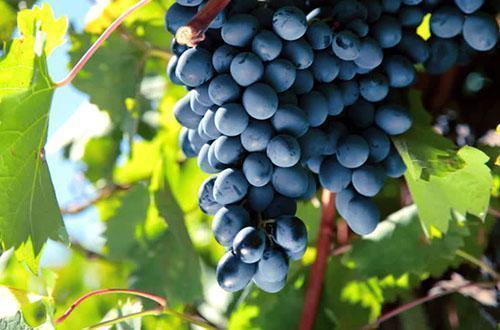 The last quarter of the 19th century prepared serious tests for European viticulturists in the form of previously unknown crop diseases, among which was downy mildew. In the Old World, the study of mildew, a dangerous disease of grape leaves and the entire plant as a whole, was begun in 1878, and 18 years later, the first case of vineyard damage was registered in Russia.
The last quarter of the 19th century prepared serious tests for European viticulturists in the form of previously unknown crop diseases, among which was downy mildew. In the Old World, the study of mildew, a dangerous disease of grape leaves and the entire plant as a whole, was begun in 1878, and 18 years later, the first case of vineyard damage was registered in Russia.
The entire aerial part of the bush suffers from the microscopic fungus Plasmopara viticola settling on grapes.
The uncontrolled development of the disease threatens with drying of shoots and affected leaves, much less berries are formed, and the resulting ovary rots and falls off. To cope with a serious enemy and not lose most of the harvest is possible only by clearly representing the picture of the disease, its development, and adhering to all measures to combat mildew on grapes.
Mildew painting on grapes: photo and description
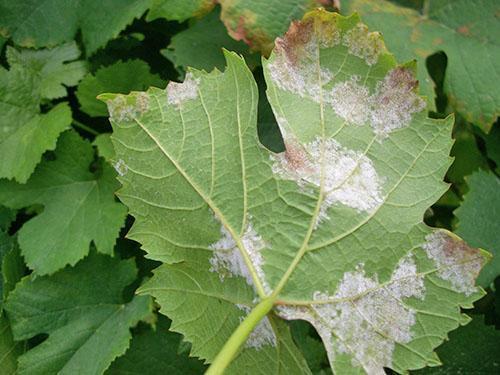 The first signs of mildew are more often found on the leaves. The dispersal of the fungus at the beginning of the growing season is indicated by oily traces on their upper surface and an inconspicuous whitish bloom on the back of the leaf plate. Moreover, a specific fluff, meaning sporulation, is better visible on young parts of shoots and leaves. Depending on humidity and air temperature, plant varieties and the stage of development of the disease, grape leaves in the middle of the shoot are covered with reddish or yellowish spots of various shapes and sizes.
The first signs of mildew are more often found on the leaves. The dispersal of the fungus at the beginning of the growing season is indicated by oily traces on their upper surface and an inconspicuous whitish bloom on the back of the leaf plate. Moreover, a specific fluff, meaning sporulation, is better visible on young parts of shoots and leaves. Depending on humidity and air temperature, plant varieties and the stage of development of the disease, grape leaves in the middle of the shoot are covered with reddish or yellowish spots of various shapes and sizes.
As the fungus is damaged and spread, necrosis of the leaf plate begins, the loss of foliage leads to a general weakening of the bush and deterioration of the quality of the berries.
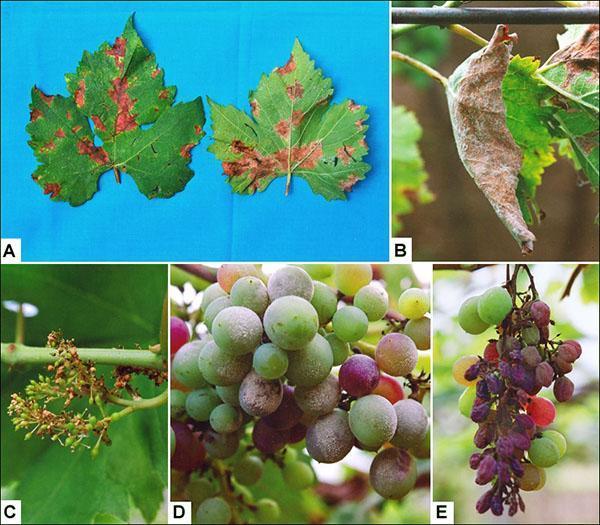 The ingress of the fungus on the shoots is not accompanied by the appearance of oily spots. Here you can immediately notice grayish or brownish traces of drying tissue. Most quickly, grape mildew, as in the photo, affects inflorescences, young parts of shoots and an ovary that has not yet reached the size of a pea. At the same time, in humid conditions, a specific white bloom is able to completely cover flowering brushes and clusters with an ovary in two days, which turns brown and quickly dies off.
The ingress of the fungus on the shoots is not accompanied by the appearance of oily spots. Here you can immediately notice grayish or brownish traces of drying tissue. Most quickly, grape mildew, as in the photo, affects inflorescences, young parts of shoots and an ovary that has not yet reached the size of a pea. At the same time, in humid conditions, a specific white bloom is able to completely cover flowering brushes and clusters with an ovary in two days, which turns brown and quickly dies off.
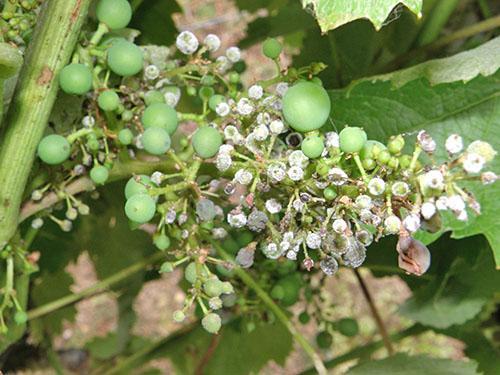 Berries affected by the fungus at the stage of filling or ripening darken, shrivel and dry out. And on already ripe fruits, mildew appears as a depressed, discolored spot in the flesh in the region of the stalk. Over time, such berries also turn brown and crumble.
Berries affected by the fungus at the stage of filling or ripening darken, shrivel and dry out. And on already ripe fruits, mildew appears as a depressed, discolored spot in the flesh in the region of the stalk. Over time, such berries also turn brown and crumble.
The causative agent of grape leaf disease
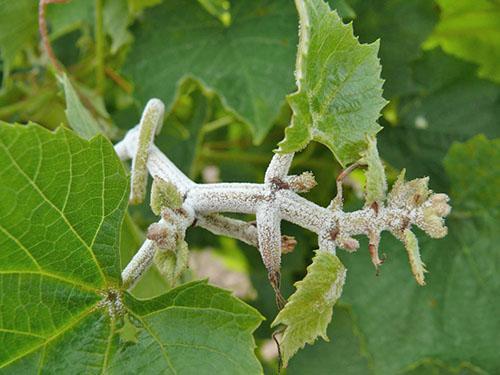 Mildew or downy mildew is caused by a fungus that hibernates in the form of spores right under the bushes of grapes, in the foliage that has fallen in the fall. Thanks to its resistance to frost, the pathogen of downy mildew safely waits out the cold season, and already at temperatures from +8 ° C it becomes active and settles on the green parts of the bushes with wind or rain drops.
Mildew or downy mildew is caused by a fungus that hibernates in the form of spores right under the bushes of grapes, in the foliage that has fallen in the fall. Thanks to its resistance to frost, the pathogen of downy mildew safely waits out the cold season, and already at temperatures from +8 ° C it becomes active and settles on the green parts of the bushes with wind or rain drops.
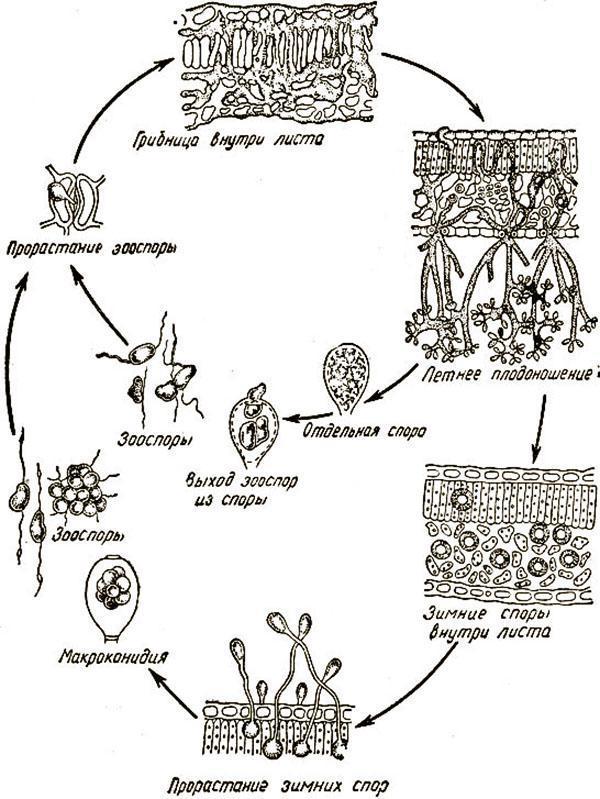 Plant infection occurs when the zoospore finds its stomata on the leaf tissue and becomes fixed. To understand the course of grape disease and how to treat leaves and other mildew-affected parts of the bush, it is important to figure out the cyclicality of infection and reproduction.
Plant infection occurs when the zoospore finds its stomata on the leaf tissue and becomes fixed. To understand the course of grape disease and how to treat leaves and other mildew-affected parts of the bush, it is important to figure out the cyclicality of infection and reproduction.
The duration of the reproduction period of a harmful fungus depends on temperature, and its favorable outcome depends on air humidity. For the development of mildew on grapes, the optimal conditions can be considered a temperature of 20 to 27 ° C and the period when the bush remains wet for more than four hours in a row.
At this time, the incubation period for grape leaf disease is dramatically reduced.During the season, the causative agent of the disease gives from 6 to 8 generations, while the incubation period on both leaves and berries, by August, becomes noticeably shorter. Until the temperature at night drops to + 12 ° C, a whitish fluff appears above the stomata, which are clusters of spore carriers. Getting into new areas of the plant with the wind, especially in wet weather, sporangia release new zoospores, and the cycle of mildew infection of grapes, as in the photo, is repeated.
Protective measures against mildew on grapes
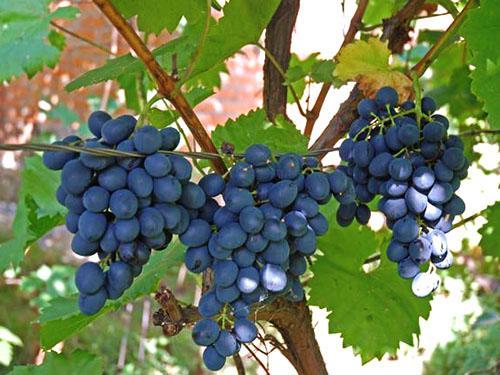 The gardener can take the first measures to protect against a dangerous disease even at the stage of laying the vineyard. Not all varieties have the same susceptibility to downy mildew. Back in the century before last, it became clear that the fungus, which caused serious damage to European plantations, could not affect the yield and vitality of American grapes. Moreover, in plants resistant to mildew, if the penetration of spores into the tissues occurs, then the further development of the fungus does not follow. In order not to observe live the manifestations of the disease of grape diseases, presented in the photo, and not to wonder how to treat leaves and shoots, it is better to select in advance varieties that are rarely affected by mildew.
The gardener can take the first measures to protect against a dangerous disease even at the stage of laying the vineyard. Not all varieties have the same susceptibility to downy mildew. Back in the century before last, it became clear that the fungus, which caused serious damage to European plantations, could not affect the yield and vitality of American grapes. Moreover, in plants resistant to mildew, if the penetration of spores into the tissues occurs, then the further development of the fungus does not follow. In order not to observe live the manifestations of the disease of grape diseases, presented in the photo, and not to wonder how to treat leaves and shoots, it is better to select in advance varieties that are rarely affected by mildew.
Today, breeders offer grape varieties that are relatively resistant to downy mildew, both table and universal, as well as for technical purposes.
Such plants include the Muromets variety, which gives dark-colored dessert berries in the early stages, Dnestrovsky Muscat, Autumn Pink grapes, Moldova variety, Magaracha's Gift and other varieties.
But even when breeding resistant varieties, you cannot do without mandatory preventive measures to combat mildew on grapes.
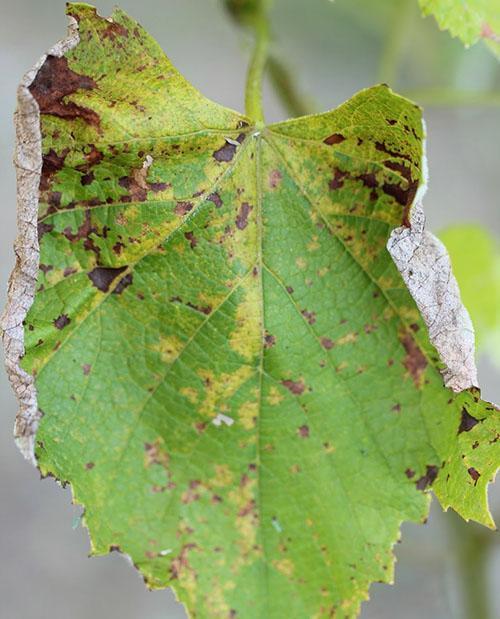 Growers noticed that more often downy mildew are affected:
Growers noticed that more often downy mildew are affected:
- young bushes and only seedlings planted from the school;
- plants that are regularly fertilized with products containing nitrogen, but lacking potassium;
- planting with a thickened crown impervious to air and sun;
- bushes, under which weeds are preserved and fallen leaves are not removed;
- vineyards in regions with a humid warm climate.
Although the main measures for controlling grape mildew involve the use of chemical treatments, the effect of such drugs can be enhanced by regular planting maintenance.
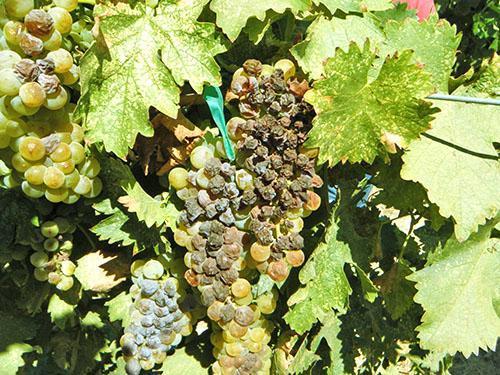 To reduce the risk of disease in the bushes will help:
To reduce the risk of disease in the bushes will help:
- the location of the trellises along the direction of the prevailing winds in a particular area;
- arrangement of wide row spacings;
- pruning grapesproviding ventilation of all shoots;
- regulation of the load on plants;
- high-quality garter of shoots, wreckage, chasing and pinching;
- timely removal of weeds and plowing or collection of fallen leaves.
But how to determine the time of processing grape leaves from the disease, and how to treat the plant if the first signs of the disease have already appeared?
Spraying grapes from mildew as a measure to combat a dangerous disease
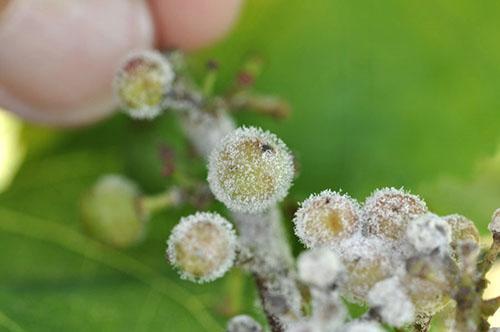 The timing of the chemical treatment of the vineyard with mildew primarily depends on the appearance of oily spots on the green parts of the plant. The effect of protection will be greatest if, by the time the spore-bearers appear, the surface of the leaves, inflorescences and shoots are completely covered with a layer of the preparation. This means that processing should be carried out shortly before a whitish fluffy bloom becomes noticeable on the back of the foliage.
The timing of the chemical treatment of the vineyard with mildew primarily depends on the appearance of oily spots on the green parts of the plant. The effect of protection will be greatest if, by the time the spore-bearers appear, the surface of the leaves, inflorescences and shoots are completely covered with a layer of the preparation. This means that processing should be carried out shortly before a whitish fluffy bloom becomes noticeable on the back of the foliage.
The first spraying is done before flowering, and if last year the disease on the grape leaves was serious, it is especially important to process the vineyard as soon as the temperature rises above +8 ° C and the first heavy rainfall falls.
When choosing the time for the first treatment of bushes, you can focus on the appearance of the first 3-4 leaves, and further spraying is planned based on the appearance and development of the fungus on the vine.
Treatment of bushes after flowering is aimed at protecting the ovary, after the calyx has fallen off the most susceptible to disease.If signs of the disease become visible when the grapes are actively blooming, the treatment is not postponed, but are approached using products that do not contain copper. When an ovary is shown on the hands, treatments are necessary depending on the weather and the manifestation of the disease.
Bordeaux mixture for the treatment of grapes from downy mildew
The oldest and most proven remedy for mildew control is Bordeaux liquid, which is a mixture of solutions of quicklime and copper sulfate. In addition to downy mildew, the agent is used against anthracnose and other grape diseases, therefore it can be used as a measure of comprehensive prevention and treatment. For the manufacture of the mixture, you can take both a ready-made, mass-produced drug, and use individual components.
If the treatment is carried out before the buds open, the concentration of vitriol in the solution is 3%, but when spraying the leaves and green parts of the plant, such a content of the active element will cause a serious burn.
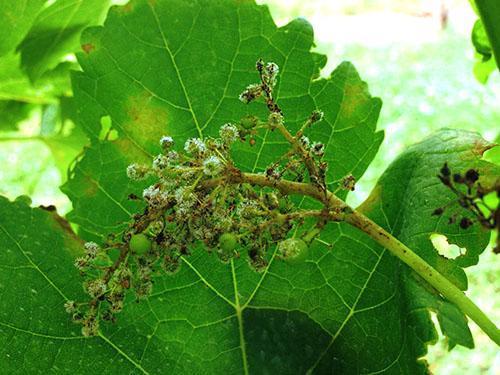 Therefore, for later processing and treatment of grapes with a Bordeaux mixture, immediately before the procedure, a 1% composition is made.
Therefore, for later processing and treatment of grapes with a Bordeaux mixture, immediately before the procedure, a 1% composition is made.
From 5 liters of hot water and 100 grams of copper sulfate, stirring thoroughly, make a solution. Then in a separate container in 10 liters of water 75 grams of lime and also thoroughly stir. A solution of copper sulfate is carefully poured into the milk of lime, the resulting product is mixed and filtered.
Bordeaux mixture for the treatment of grapes, it should be used without delay, while remembering that its protective properties are lost after the first rain, which means that the treatment will have to be repeated. When spraying, special attention is paid to young growth and the back of the foliage.
Fungicides - drugs against fungal diseases
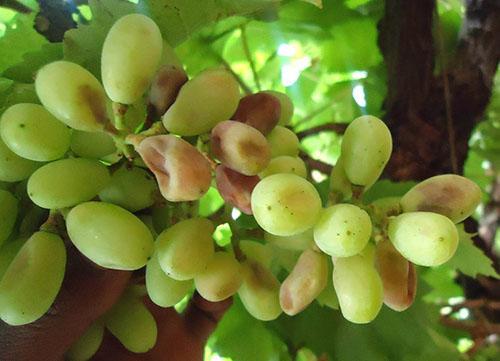 To make the treatment of grapes with Bordeaux mixture more effective, the agent can be mixed with colloidal sulfur, a yellowish powder that does not harm humans, which exhibits a bright effect against fungi and ticks. At the same time, sulfur weakens the toxic effect of the copper preparation, and the vine receives protection not only from mildew, but also from powdery mildew.
To make the treatment of grapes with Bordeaux mixture more effective, the agent can be mixed with colloidal sulfur, a yellowish powder that does not harm humans, which exhibits a bright effect against fungi and ticks. At the same time, sulfur weakens the toxic effect of the copper preparation, and the vine receives protection not only from mildew, but also from powdery mildew.
Copper chloride is the main active ingredient in fungicides such as Abiga-peak and Hom, used against oidium, mildew and grape anthracnose. An effective drug for the causative agent of downy mildew is Delan.
Today, for the treatment of mildew, in addition to the Bordeaux liquid, in the arsenal of the grower there are a number of effective preparations, both containing copper, and based on other active ingredients.
As a substitute for the Bordeaux mixture in the treatment of grapes or as an addition to it, a lime-sulfur broth can be used. A brownish or dark orange liquid with a predominant odor of hydrogen sulfide, ISO, is also active against ticks and fungi infecting grapes.
Alirin-B and Planriz are representatives of a class of microbiological agents recommended for treating vines against gray mold, powdery mildew and mildew.
Fungicide Strobi for grapes
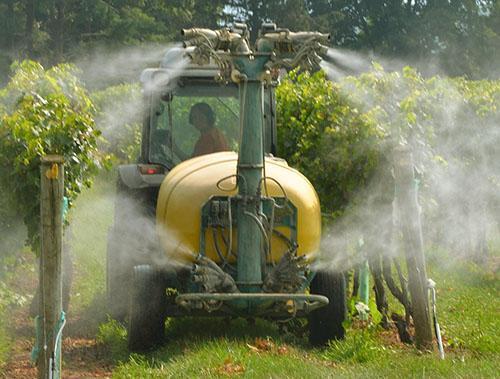 The active substance of this modern remedy is fixed on the treated parts of the plant, is released within several weeks and does not allow the spores of the fungus to germinate, providing long-term and reliable protection of the vine from mildew and oidium.
The active substance of this modern remedy is fixed on the treated parts of the plant, is released within several weeks and does not allow the spores of the fungus to germinate, providing long-term and reliable protection of the vine from mildew and oidium.
Resistant to rainfall and not hazardous to grapes Strobi:
- not only protects plants from fungi that stimulate oidium and mildew, but also promotes the ripening of shoots;
- valid from 8 to 12 days;
- can be used with other drugs.
Moreover, more than three treatments of Strobi grapes per season are not allowed.
Ridomil Gold for the prevention of mildew on grapes
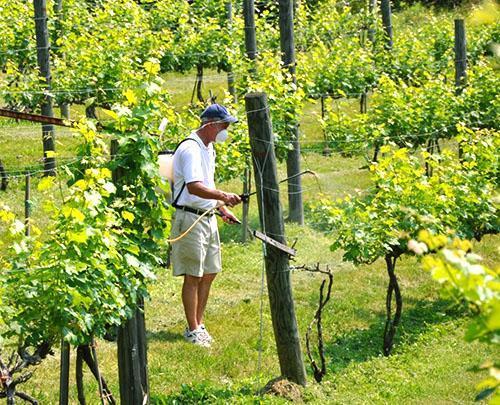 This systemic fungicide is used prophylactically against downy mildew and other grape diseases. The agent is slightly toxic and compatible with other drugs, and when alternating with contact fungicides, Ridomil Gold is most effective.
This systemic fungicide is used prophylactically against downy mildew and other grape diseases. The agent is slightly toxic and compatible with other drugs, and when alternating with contact fungicides, Ridomil Gold is most effective.
Treatment of healthy vines at risk of mildew infection is carried out in dry, calm weather when there is no danger of burns for the bush.
The spray effect lasts from 7 to 10 days. The advantages of using Ridomil Gold on grapes are that:
- the product, dried on foliage and shoots, is not washed off by dew and precipitation;
- protection extends to untreated parts of the vine, including the growth formed after processing.
If there are signs of disease on the leaves of grapes, it is necessary to treat the plant with a curative action fungicide and only then, after a week, apply Ridomil Gold.
Mildew grape diseases - video
if you only knew how dear the grape leaves are to me! I have a friend who is Armenian and she taught me how to cook just the best stuffed cabbage rolls wrapped in grape leaves. And my husband now adores them, but he doesn't eat simple cabbage rolls at all .. do you really think that this is the most effective method of treating grape leaves? and is there no longer term remedy? thank!
Hello. The pensioner asks for help. I am sending the photo. What should I do?
Here's another photo of sick grapes? How is he sick and how to treat?
And another photo ...
And further. ..
Hello! Your grapes have a whole range of diseases, which is observed everywhere in table varieties. Unfortunately, diseases can only be overcome with the help of systemic and contact fungicides. This year's harvest cannot be restored, but the bushes can be saved. The article contains the most effective recommendations for the treatment of diseased plants. Follow them.
appeared on the grapes quite a lot. the grapes have very little to ripen. what to do
Try a thorough contact fungicide treatment. There are many of them in stores, you need to pick them up for grapes. It works immediately after treatment, but is washed off by the first rain. Before use, the grapes must be rinsed well in running water. Last treatment 10 days before harvest. Unfortunately, at this stage, other tools no longer help.
What kind of disease is it? I noticed it recently. How to treat?
This is a lesion of the leaf plate by phylloxera. It's too late to process now. leaves must be torn off and burned.
Thank you very much for your answer and advice!
There are stains on the leaves of Rapture. What is it?
This is oidium (powdery mildew)
On the Kesha berries - dots, as from punctures. Then the bunch will die. What is it?
Your grapes are hit with anthracnose.
Good evening! Please tell me, we are novice gardeners, there are a lot of grape bushes on the site, half of the brushes are almost ripe, and a gray bloom has appeared on the shoots and fruits, and those that are greener have begun to disappear ((Is there really nothing to help our crop? Thank you!
The grapes are afflicted with the human being. Now it is impossible to do the treatment with chemicals. Read the previous comments for advice on using folk remedies. Some of the harvest has already been lost.